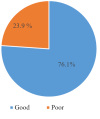Self-screening practice of breast cancer and associated factors among female students in Ethiopian universities using the theory of planned behavior: a cross sectional study
- PMID: 39567988
- PMCID: PMC11577714
- DOI: 10.1186/s12905-024-03463-8
Self-screening practice of breast cancer and associated factors among female students in Ethiopian universities using the theory of planned behavior: a cross sectional study
Abstract
Background: Breast cancer is the most common cancer among females. Assessing self-screening practices for breast cancer patients is vital for developing targeted interventions. The current study aimed to assess self-screening practices for breast cancer and associated factors via the theory of planned behavior constructs among female students in Ethiopian universities.
Methods: A cross-sectional study design was conducted using the theory of planned behavior constructs. The data were collected from January 30, 2022, to February 30, 2022, in Ethiopia. A structured, self-administered questionnaire was used. The validity and reliability tests were checked to use the questionnaire in the main study through a pilot test. The data were collected through online Google Forms by distributing them to university students via Telegram groups, Imo, emails, and Facebook. The collected data were exported to SPSS version 26 for analysis. Bivariate analysis was used to identify the candidate variables for multiple logistic regression (P value < 0.02). Those variables with a P value less than 0.05 were considered significant predictors of breast cancer screening practices.
Results: A total of 418 female students participated in the study. The respondents were aged between 18 and 37 years. In the current study, 318 (76.1%; 95% CI: 72.0, 80.4) university students had good screening practices for breast cancer. Nonhealth-related departments (AOR = 1.95; 95% CI: 1.11, 3.44), having training in breast cancer self-examination (AOR = 1.87; 95% CI: 1.04, 3.35), having a good attitude (AOR = 1.96; 95% CI: 1.11, 3.47), having good behavioral control (AOR = 4.1; 95% CI: 2.18, 7.71), and having good behavioral intentions (AOR = 1.88; 95% CI: 1.09, 3.24) were associated with self-screening practices for breast cancer patients.
Conclusion: Designing a theory of planned behavior-based educational interventions improve self-screening practices for breast cancer among university female students. These insights could guide the development of future breast cancer awareness and prevention programs in university settings, with the goal of increasing early detection rates and lowering the risk of breast cancer. The study also serves as foundational information for designing future research using more advanced study design methods.
Keywords: Breast cancer; Female university students; Screening practice; Theory of planned behavior.
© 2024. The Author(s).
Conflict of interest statement
Declarations. Ethics approval and consent to participate: The study was approved by the ethical review committee members of the School of Pharmacy, University of Gondar, with reference number SOP/45/2014. A statement confirming that all the experimental protocols were approved by a named institutional and/or licensing committee was signed by Mr. Abyot Endale, Mr. Zemene Demelash, Mr. Asmamaw Emagn, Mr. Nurahimed Seid, and Mr. Gizework Aleminew. Written informed consent was obtained from each study participant. All methods were carried out in accordance with the Declaration of Helsinki. Consent for publication: Not applicable. Competing interests: The authors declare no competing interests.
Figures




Similar articles
-
Breast Cancer Awareness, Screening Practices, and Perceived Barriers Among Female Undergraduate Students: An Institution-Based Cross-Sectional Study.Cancer Rep (Hoboken). 2025 Mar;8(3):e70187. doi: 10.1002/cnr2.70187. Cancer Rep (Hoboken). 2025. PMID: 40099672 Free PMC article.
-
Knowledge on risk factors and practice of early detection methods of breast cancer among graduating students of Debre Tabor University, Northcentral Ethiopia.BMC Womens Health. 2022 May 18;22(1):183. doi: 10.1186/s12905-022-01768-0. BMC Womens Health. 2022. PMID: 35585540 Free PMC article.
-
Breast Self-Examination Knowledge and its Determinants among Female Students at Addis Ababa University, Ethiopia: An Institution-Based Cross-Sectional Study.Biomed Res Int. 2022 May 30;2022:2870419. doi: 10.1155/2022/2870419. eCollection 2022. Biomed Res Int. 2022. PMID: 35677100 Free PMC article.
-
Breast Self-Examination Practice Among Female University Students in Ethiopia: A Systematic Review and Meta-Analysis.Cancer Control. 2021 Jan-Dec;28:10732748211019137. doi: 10.1177/10732748211019137. Cancer Control. 2021. PMID: 34169755 Free PMC article.
-
Ethiopian women's breast cancer self-examination practices and associated factors. A systematic review and meta-analysis.Cancer Epidemiol. 2022 Jun;78:102128. doi: 10.1016/j.canep.2022.102128. Epub 2022 Mar 8. Cancer Epidemiol. 2022. PMID: 35272259
Cited by
-
Breast cancer awareness, knowledge and self-screening intention among females in Northern Border of Saudi Arabia, Arar City.BMC Public Health. 2025 Mar 11;25(1):964. doi: 10.1186/s12889-025-22092-w. BMC Public Health. 2025. PMID: 40069709 Free PMC article.
References
-
- Bray F, Laversanne M, Sung H, Ferlay J, Siegel RL, Soerjomataram I, Jemal A. Global cancer statistics 2022: GLOBOCAN estimates of incidence and mortality worldwide for 36 cancers in 185 countries. Cancer J Clin. 2024;74(3):229–63. - PubMed
-
- Guilford K, McKinley E, Turner L. Breast cancer knowledge, beliefs, and screening behaviors of college women: application of the health belief model. Am J Health Educ. 2017;48(4):256–63.
-
- Chin JH, Mansori S. Theory of Planned Behaviour and Health Belief Model: females’ intention on breast cancer screening. Cogent Psychol. 2019;6(1):1647927.
MeSH terms
LinkOut - more resources
Full Text Sources
Medical

